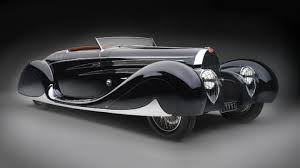The Great Depression was slow to impact France, due to that country’s
high tariffs and restricted trade, but by the early 1930's, sales of
luxury automobiles dwindled. Ettore Bugatti and his brilliant son Jean
understood that a special model was imperative to help their company
survive. The resulting new Type 57’s styling was at once contemporary
and affordable, with custom coachwork available for the very wealthy.
For
racing, a normally-aspirated, 3.3-liter straight 8-powered Type 57, on
an ultra-low “S” chassis, was fitted with streamlined open coachwork.
The factory successes included averaging 135.45 mph for one hour, 123.8
mph for 2,000 miles, and 124.6 mph for 4,000 kilometers. An avid
horseman, “Le Patron,” as Bugatti was known, was convinced automobile
competition improved the breed, as it did with thoroughbred racing.
The
greatest coachbuilders of France: Gangloff, Saoutchik, Letourneur &
Marchand, and Vanvooren, as well as Britain’s Corsica, and Graber of
Switzerland, all built custom coachwork on the Type 57 chassis. This
special Type 57C was the property of Mohammed Reza Pahlavi, Prince of
Persia and future Shah of Iran.
When Pahlavi married Egypt’s
Princess Fawzia, many nations sent extravagant wedding presents. A gift
from France, this cabriolet’s drophead coachwork—a study in sweeping
lines and fluid Art Deco ornamentation—was constructed by coachbuilder
Vanvooren of Paris, in the style of Figoni & Falaschi. The
windscreen can be lowered into the cowl for an even racier appearance.
Source: Internet
skip to main |
skip to sidebar
Translate
World Clock
Visitor Map
FEEDJIT Live Traffic Feed
Site Counter
- As The Wheels Turned, So Did The Days Of My Life..,
- Automobile Brands Of The Past
- Born And Raised In The South..,
- Do It Yourself (DIY) Crochet Tips and Crafts For Your Home
- Great Deep South Recipes
- Growing Up In The South
- Harrell And Cox Family
- Inspiring Thoughts...,
- Our Health And Nutrition
- Songs We Sang While Growing Up In The South
- Tennessee Granddaddy
- The P.Y. Waters Family And Their Descendents
- Waters In Tennessee
- We Love Ford's Past, Present And Future..,
- We Love Lincoln's Past, Present And Future..,
- We Love Mercury's Past, Present And Future..,
- We Love Volkswagen Past, Present And Future..,
- Wilber P And Lucy Hamilton Beard Family And Descendents
Followers
Blog Archive
-
▼
2013
(235)
-
▼
August
(68)
- GM Motorama Showcased Dream Cars In The 1950's
- What Is The Classic Car Capital Of The World?
- What Are British Classic Cars Called?
- GM Designer Paul Deesen, the Pontiac Strato Star, ...
- Harley Earl’s 1951/1954 Le Sabre
- Jeff Gold’s Rescued Studio Art Collection
- Raymond Loewy and Streamline Moderne
- Custom Cars And Lead Sleds
- Two-Tone Cars Of The Fifties
- Chevrolet Paint Colors in the 50's
- Detroit Needed to Know
- Station Wagons Our Parents Drove
- Show Cars of the 50's
- 1947-1955 Chevrolet Trucks
- Citroën 2CV
- Microcar
- Peel Trident
- Zündapp Janus
- Meadows Frisky
- Bubble Cars
- Most Sought After Muscle Cars
- How Sports Cars Work
- Classic Cars of the 1980's
- Classic Cars of the 1970's
- Classic Cars of the 1960's
- Classic Cars of the 1950's
- Classic Cars of the 1940's
- Classic Cars of the 1930's
- Classic Cars
- 1962 and 1963 Chevrolet Corvair Concept Cars
- Ford Econoline Pickup (1961-1967)
- A-100 Dodge Pickups
- VW Transporter Pickups
- 1955 Chevrolet Cameo Pickup
- History of the Chevy Cameo Truck
- 1962 Chevrolet Corvair Truck
- 1963 Chevrolet Corvair 95 Rampside Pickup
- Pictures Of Chevrolet Corvair Pickups
- Pictures Of Cameo Pickups
- Chevrolet Cameo Pickups 1955-1958
- Cheverolet "Apache" Pickups
- Chevrolet Advance Design
- Chevrolet Task Force
- Art Deco Trucks
- 1941 Graham Hollywood
- Stutz Model 6 Blackhawk
- American Austin Car Company
- 1941 Chrysler Thunderbolt
- 1939 Bugatti Type 57C by Vanvooren
- Tatra T97
- 1938 Tatra T97
- Talbot-Largo
- 1938 Talbot-Lago T-150C-SS Teardrop Coupe
- 1938 Hispano-Suiza H6B Dubonnet “Xenia” Coupe
- 1937 Delahaye 135MS Roadster
- 1936 Delahaye 135M Figoni & Falaschi Competition C...
- 1935 Chrysler Imperial Model C-2 Airflow Coupe
- 1936 Stout Scarab
- 1934 Voisin Type C27 Aérosport Coupe
- 1934 Packard Twelve Model 1106 Sport Coupe
- Model 40 Special Speedster
- Pierce-Arrow Motor Car Company
- Cord Automobile
- Bugatti Type 46
- Art Deco Automobiles
- Classic Carhaulers
- Classic Cars
- What A Wreck!
-
▼
August
(68)
